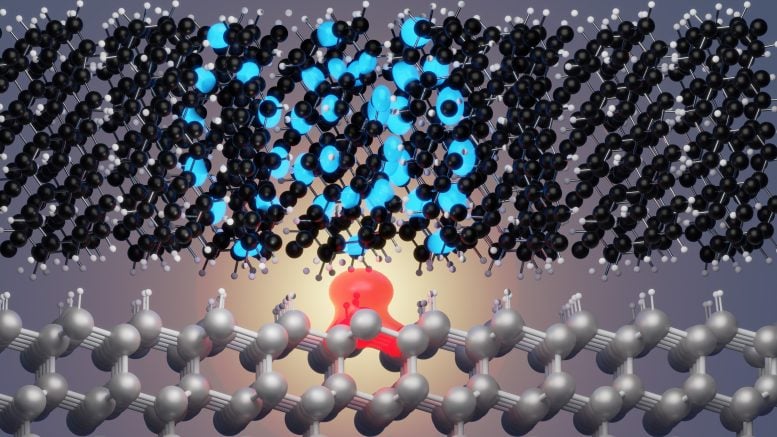
This image shows a visualization of the calculated exciton transfer from an upper tetracene layer of a solar cell to the silicon substrate. The electron is shown in blue, and the electron hole in red. Credit: Marvin Krenz, University of Paderborn
Researchers at the University of Paderborn are enhancing the efficiency of solar cells through the strategic incorporation of imperfections in the system’s design.
Since the beginning of the 21st century, Germany has seen significant progress in the realm of solar energy. In 2000, solar power contributed to less than one percent of its electricity production. However, by 2022, this percentage had escalated to approximately 11 percent. This growth was propelled by a mix of generous financial incentives for residential solar installations and technological advancements that reduced the cost of solar panels.
With global conflicts making oil and natural gas markets less reliable, solar power stands to play an even larger role in helping meet Germany’s energy needs in the years to come. While solar technology has come a long way in the last quarter century, the solar cells in contemporary solar panels still only operate at about 22 percent efficiency on average.
In the interest of improving solar cell efficiency, a research team led by Prof. Wolf Gero Schmidt at the University of Paderborn has been using high-performance computing (HPC) resources at the High-Performance Computing Center Stuttgart (HLRS) to study how these cells convert light to electricity. Recently, the team has been using HLRS’s Hawk supercomputer to determine how designing certain strategic impurities in solar cells could improve performance.
“Our motivation on this is two-fold: at our institute in Paderborn, we have been working for quite some time on a methodology to describe microscopically the dynamics of optically excited materials, and we have published a number of pioneering papers about that topic in recent years,” Schmidt said. “But recently, we got a question from collaborators at the Helmholtz Zentrum Berlin who were asking us to help them understand at a fundamental level how these cells work, so we decided to use our method and see what we could do.”
Recently, the team used Hawk to simulate how excitons — a pairing of an optically exited electron and the electron “hole” it leaves behind — can be controlled and moved within solar cells so more energy is captured. In its research, the team made a surprising discovery: it found that certain defects to the system, introduced strategically, would improve exciton transfer rather than impede it. The team published its results in SciTechDaily